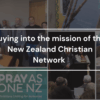What is the “spirit” of the Treaty of Waitangi? Often discussion of this question is focussed exclusively on the text of the Treaty itself. But it is also helpful to consider the wider ceremonial context in which the Treaty was first enacted. In considering the spiritual significance of the Treaty, I would like to highlight three features of its signing: Hobson’s greeting, Patuone’s gift, and the distribution of treaty blankets.
Hobson’s greeting
As each rangatira signed the treaty, Governor Hobson shook their hand and said, “He iwi tahi tatou” (We are one people). This whakataukī (significant saying) apparently delighted Māori, but what would they have understood by it? In the first instance, Māori would have recognised a confirmation of Henry Williams’ explanation. Williams, the leading Anglican missionary, had told them that by signing, “they would become one people with the English… under one Sovereign, one Law, human and divine.” But for many Māori, the words would also have resonated deeply with the Bible: “For Christ is our peace, having made both groups [Jew and Gentile] into one.” (Ephesians 2:14). Hobson’s greeting linked the sacred and the secular in a way that would have made perfect sense to Māori of the day.
Patuone’s gift
After the signing, Patuone, a leading Ngā Puhi rangatira and peacemaker, stepped forward and presented Hobson with a mere pounamu (a greenstone hand weapon) intended expressly for Queen “Wikitoria”. Mathew Felton, a member of Hobson’s entourage and the one who reported the gift, recognised the value of such a rare taonga, but seemed unaware of its deeper significance. For, rangatira who wished to make peace with an enemy would send their mere pounamu to their opponent, who, by accepting it, would establish an enduring peace between their hostile iwi. Consequently, the 500 or so Māori who gathered to witness the signing would not have missed the significance of Patuone’s gift. If the act of signing the Treaty sealed the agreement from a British standpoint, the presentation of the mere pounamu by Patuone was its cultural equivalent from a Māori perspective. It was a fitting response to Hobson’s greeting and linked the Treaty to traditional practises of peacemaking.
Treaty blankets
At the end of the ceremony, Hobson asked the missionary printer, William Colenso, to distribute a bale of blankets and a cask of tobacco to all those who signed. It was an exchange viewed with cynicism by later generations of settlers, who resented what they called the “blanket treaty”. Yet to see this distribution as merely a bribe to “naked savages” is to be insensitive to the cultural protocols involved. Hobson, with his western sensibilities, had been careful to withhold any gifts until the ceremony was completed, and yet, to have not offered a koha would have been interpreted as a deliberate insult within a culture that placed such importance on reciprocity and hospitality. In later years, the red treaty blankets were worn as a mark of distinction by Māori rangatira in much the same way that the grey missionary blanket had earlier demonstrated a willingness to hear the missionary karakia. For Māori, what you wore was an important indication of your beliefs and allegiances. “Give me a blanket that I might believe!” was perplexing to the missionary who was looking for an inward conversion of the heart, but it reminds us that for a number of early converts the social expression of faith was just as important as its profession; how can you believe if disconnected from the community of faith by your very appearance? Hence, Māori enthusiasm for treaty blankets was not a sign of short-sighted avarice, but of a newly-formed allegiance and a continuing recognition of the agreement.
Implications
If the spiritual dimension of the treaty was important to all those involved in its first signing, it should continue to enrich our understanding of the document even in this secularising age. For just as a marriage licence cannot fully express the intentions of the happy couple, the “spirit” of the Treaty cannot be confined to the legal dissection of written texts, however important that may be. The first Māori Bishop, Fredrick Bennett, in urging New Zealanders never to forget the Treaty’s spiritual side, defined that spirit as “unity and peace between the Pakeha and Maori for all time”. His definition follows naturally as a succinct summary of Hobson’s greeting and Patuone’s gift. And as we heed the Bishop’s call, may we as a nation cloak our life together in the spiritual blanket that is the Treaty of Waitangi.









0 Comments